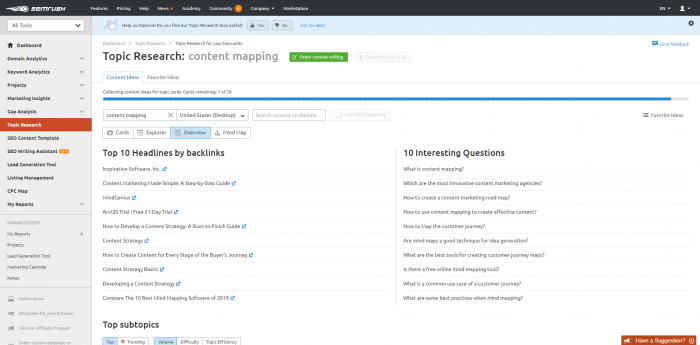Content Mapping Made Simple: A Step-By-Step Guide
Last updated on January 10, 2022 by Nikola Banicek 7 min readIntroduction
The importance of content has been proven numerous times through various tests and “leaks” from Google on how their algorithms work.
However, not all content is important or relevant, that is why websites and their blogs need to have a clear structure and idea behind them.
Studies have confirmed that small businesses with blogs get 126% higher lead growth than small businesses without blogs. That is the reason why content mapping became an important process for every business.
But, what is content mapping?
Content mapping is a tool/process that helps businesses to understand their audience better.
More precisely, it explains how to effectively guide potential customers through the customer journey.
The point of successful content mapping is to gather a bigger number of leads that will become buyers one day.
Advantages of Effective Content Mapping Strategy
Many businesses are not aware of the benefits they can get thanks to this method.
We would like to highlight 2 advantages that will help you make better results.
1. Meeting Your Customers
You will define the path which each customer takes before he does business with you.
On that “road”, they will show which needs, goals, and concerns they have.
Understanding the characteristics of your target audience will help you develop a better marketing strategy.
2. Better Sales
It doesn’t matter if you actively update content on your website.
If the number of sales remains the same, your strategy is not effective enough.
This method of work helps business owners make a catalog of their content.
First of all, you won’t duplicate the content that you have. Doing something like that is monotonous and it will have a negative impact on your potential buyers.
Besides that, it will show you which content is perfect for a certain stage of a sales funnel.
Publishing many things on your website daily will not guarantee you success. Each piece that you publish needs to have a purpose.
How to Develop Successful Content Mapping Strategy
Content production is a complex process. It is recommendable to surround yourself with quality people that will help you scale content production successfully.
You will have to use different methods to satisfy visitors in different stages of the funnel.
Anyway, there are 6 different steps that you need to go through that will help you use this tool successfully.
Develop a Buyer Persona
Getting to know your target audience is the first step that you need to take.
A buyer persona is an in-depth analysis of your ideal audience. It explains what your potential customers would want to see, know, and need.
There are several different things that you will discover thanks to this step:
- Demographics – These are basic things such as gender, age, geographical location, family situation, etc. Many businesses focus too much only on demographics. Yet, these pieces of information are not enough to make a clear picture of your audience.
- Professional Role – You will find out the industry, current job title, the size of the company they work at, etc.
- Goals and Values – This part is especially important. You have to find out which things your customers value the most. When you understand their mentality and lifestyle, you will exactly know which things they want to see.
- Their Reliable Sources – Your potential customers will probably have the same interests. This also means that they love similar books, blogs, individuals, etc. These pieces of information will allow you to target the so-called “look-a-like” audience.
- Buying Habits – How much are they ready to spend? Do they hesitate a lot before they need to buy a certain product? Do they individually make the buying decisions?
You can design a buyer persona template on your own. Still, there are plenty of templates around the web that can make the entire process easier.
Create a Customer Journey Map
When you find out how your ideal audience looks like, the next step is to make a customer journey map. Each potential buyer will go through a purchase funnel before he buys a product that you offer.
There are 5 different stages of a sales funnel:
- Awareness
- Engagement
- Evaluation
- Purchase
- Post-Purchase
You will be able to document some details for each stage of the funnel.
For instance, you will find out which actions customers take, which thoughts and questions they have, in which stage they spend most of their time, etc.
All these pieces of information will tell you which content attracts your customers the most.
Pick the Best Type of Content for Each Phase of Customer Journey
Let’s now analyze the previous step in detail.
Awareness is the first phase that attracts first-time visitors to your brand.
Logically, they will have many questions before they decide to buy a product. This type of content includes:
- Buying Guides
- Infographics
- Videos
- Blog Posts
- Social Media Posts, etc.
The next step is – Engagement!
Keep in mind that not every visitor is immediately going to buy some of your products. They won’t come back again if the content on your website is not interesting and engaging.
This type includes:
- Interactive Content
- Engaging Videos (Usually short, but with a valuable message)
- Email Newsletters (Call your visitors to subscribe to your newsletters)
- Blog Posts, etc.
Evaluation content is “located” in the middle of the purchase funnel. In this stage, customers are making the final decision. They will decide if your brand is good for collaboration or not.
This sort of content includes:
- Reviews and Testimonials (It is recommendable to kindly ask previous customers to share their opinion about the product and customer service)
- Landing Pages
- Case studies
- E-books, etc.
Finally – the next stage is Purchase.
In this stage, content needs to be completely optimized and convince potential customers to feel even more confident in their decision. For instance, “How-to” posts are good examples of that.
Purchase content mostly includes:
- FAQs
- Landing/Sales Pages
- Free Trial Sign-Up Pages, etc.
Still, the purchase stage is not the last one. If you stop there, customers will think that your only intention was to sell the product, yes, we’re all driven by sales but people like to be treated nicely.
So, you need to give them something more that will be of value to them and show them that you care. That’s why post-purchase is the last stage on our list.
The examples of post-purchase content are:
- Surveys
- User Guides
- Coupons (offer them a discount for the next purchase)
- Email newsletters, etc.
You should also keep in mind that customer service is something that splits you from the masses. The market is more competitive than ever before.
Many webmasters will offer equally good products like yours. Yet, providing your customers with additional value is something that will convince them to get back and purchase once again.
They will appreciate your effort to make them feel more satisfied and comfortable.
Design a Catalog of Your Content
You have probably noticed that some examples are repeating in 2 or more sales’ funnel stages.
Well, before you start with mapping, it is crucial to get familiar with the entire marketing strategy.
In that way, you won’t create and publish duplicated things on your website. Publishing similar articles, videos, or anything else won’t cause a better conversion rate.
Do not forget to put even the smallest details in the catalog. For instance:
- Title
- URL
- Category and Type
- Conversion
- Quality, etc.
Map the Content You Developed to Relevant Phases
After you made the catalog, it is the right time to start filling the content map. As mentioned, different sorts of contents are relevant for different stages.
There is one piece of advice that should be helpful. While it’s true that each phase works independently, they are still very much connected. Each phase needs to contain a “call-to-action”.
For example, if they’re reading an article closely related to one of your services, show them a lead magnet with a case study where you’ve provided that service. You can invite them to check out your social media pages, subscribe to your newsletter or simply offer them to check out another article on the subject.
However, all of that still doesn’t guarantee that everything you publish is going to bring good results. For instance, maybe your visitors would rather interact with video posts than with articles/blogs. However, that is something you will find out over time and will need to adapt to.
Check if Something Is Missing
This is a complex process and it takes time to develop a successful content mapping strategy. You have to be ready to learn from your customers. Still, you may make some gaps. If that happens, you have two different options.
The first one is to develop completely new content assets that will fill the gaps that you have made. The second is to once again go through the content catalog that you developed. Try to utilize things that you have in some other phases. For instance, try using videos in the engagement phase instead of in awareness, don’t be afraid to mix it up here and there. Testing never really stops and there is always room for improvement.
3 Useful Templates
Having the right tool for the job is of utmost importance, that’s why we’re always on the hunt to find those that will make our lives easier.
Here are three different guides with templates that you can use to create your own content mapping strategy:
By visualizing your strategy, you will have a clear picture of things that are working well, and more importantly, those that you need to fix.
Conclusion
If you’re looking for a more of an all-rounder tool, my suggestion is to try out the SEMrush All-In-One SEO tool for free. This tool helps with SEO, keyword research, and content marketing as well.
You will be able to find out if your customers love the things that you publish or not. One more perk is that signing up for this tool is free!
What do you think? Is content mapping a useful tool for developing a successful marketing strategy? Will this process raise the number of product purchases?
Share your thoughts with us!
See also
Get to know what is semantic web by checking an article written by Courtney McGhee, a true SEO master pro with a whole lotta info to share!
When choosing keywords for your campaigns, keyword search volume is one of the most important metrics to pay attention to.






